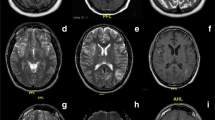Abstract
Our purpose was to determine whether triple-dose delayed contrast-enhanced images would improve lesion detection in patients with symptomatic human immunodeficiency virus (HIV) infection. We reviewed 33 MRI studies on 29 patients. Single-dose immediate T 1-weighted spin-echo (1x-T 1) images were compared with delayed triple-dose images (D3x-T 1). Two neuroradiologists decided which technique showed more lesions, increased lesion conspicuity and/or altered the radiologic diagnosis. The D3x-T 1 technique improved lesion detection in 14 of 29 patients (48 %). In two patients (7 %), the improvement changed the radiologic diagnosis by showing new meningeal lesions.
Similar content being viewed by others
Author information
Authors and Affiliations
Additional information
Received: 1 February 1999 Accepted: 11 August 1999
Rights and permissions
About this article
Cite this article
Diaz-Marchan, P., Huang, M., Jackson, E. et al. Triple-dose contrast-enhanced images in neurologically symptomatic HIV-positive patients. Neuroradiology 42, 256–260 (2000). https://doi.org/10.1007/s002340050881
Issue Date:
DOI: https://doi.org/10.1007/s002340050881




